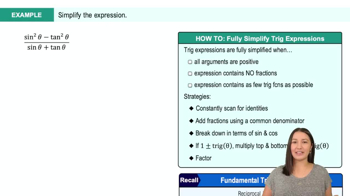Table of contents
- 0. Functions7h 52m
- Introduction to Functions16m
- Piecewise Functions10m
- Properties of Functions9m
- Common Functions1h 8m
- Transformations5m
- Combining Functions27m
- Exponent rules32m
- Exponential Functions28m
- Logarithmic Functions24m
- Properties of Logarithms34m
- Exponential & Logarithmic Equations35m
- Introduction to Trigonometric Functions38m
- Graphs of Trigonometric Functions44m
- Trigonometric Identities47m
- Inverse Trigonometric Functions48m
- 1. Limits and Continuity2h 2m
- 2. Intro to Derivatives1h 33m
- 3. Techniques of Differentiation3h 18m
- 4. Applications of Derivatives2h 38m
- 5. Graphical Applications of Derivatives6h 2m
- 6. Derivatives of Inverse, Exponential, & Logarithmic Functions2h 37m
- 7. Antiderivatives & Indefinite Integrals1h 26m
- 8. Definite Integrals4h 44m
- 9. Graphical Applications of Integrals2h 27m
- 10. Physics Applications of Integrals 2h 22m
4. Applications of Derivatives
Differentials
Problem 111
Textbook Question
Consider the lim_x→∞ (√ ax + b) / √cx + d where a, b, c, and d are positive real numbers. Show that l’Hôpital’s Rule fails for this limit. Find the limit using another method.
 Verified step by step guidance
Verified step by step guidance1
Identify the form of the limit: As x approaches infinity, both the numerator and the denominator approach infinity, creating an indeterminate form of type ∞/∞.
Apply l'Hôpital's Rule: Differentiate the numerator and the denominator with respect to x. The derivative of the numerator √(ax + b) is (a / (2√(ax + b))), and the derivative of the denominator √(cx + d) is (c / (2√(cx + d))).
Evaluate the new limit: The limit of the derivatives as x approaches infinity is (a / (2√(ax + b))) / (c / (2√(cx + d))). Simplify this expression to (a/c) * (√(cx + d) / √(ax + b)).
Observe the behavior of the simplified expression: As x approaches infinity, the expression (√(cx + d) / √(ax + b)) approaches √(c/a) because the terms b and d become negligible compared to ax and cx.
Conclude that l'Hôpital's Rule fails: The application of l'Hôpital's Rule does not resolve the indeterminate form, as the limit of the derivatives still results in an indeterminate form. Instead, use the dominant term method to find the limit, which is √(a/c).
 Verified video answer for a similar problem:
Verified video answer for a similar problem:This video solution was recommended by our tutors as helpful for the problem above
Video duration:
6mPlay a video:
Was this helpful?
Key Concepts
Here are the essential concepts you must grasp in order to answer the question correctly.
L'Hôpital's Rule
L'Hôpital's Rule is a method in calculus used to evaluate limits of indeterminate forms, such as 0/0 or ∞/∞. It states that if the limit of f(x)/g(x) results in an indeterminate form, the limit can be found by taking the derivative of the numerator and the denominator separately. However, this rule may not apply if the derivatives do not yield a determinate form or if the limit diverges.
Recommended video:
Guided course

Power Rules
Limits at Infinity
Limits at infinity involve evaluating the behavior of a function as the input approaches infinity. In this context, we analyze how the function behaves as x becomes very large. Understanding how to simplify expressions by focusing on the highest degree terms in polynomials or radical expressions is crucial for finding these limits.
Recommended video:

One-Sided Limits
Dominant Terms
In the context of limits, dominant terms refer to the terms in a function that have the greatest influence on its behavior as x approaches a certain value, such as infinity. For rational functions or expressions involving radicals, identifying these terms allows for simplification, making it easier to evaluate the limit. This concept is essential for determining the limit without relying on L'Hôpital's Rule.
Recommended video:

Simplifying Trig Expressions Example 1







